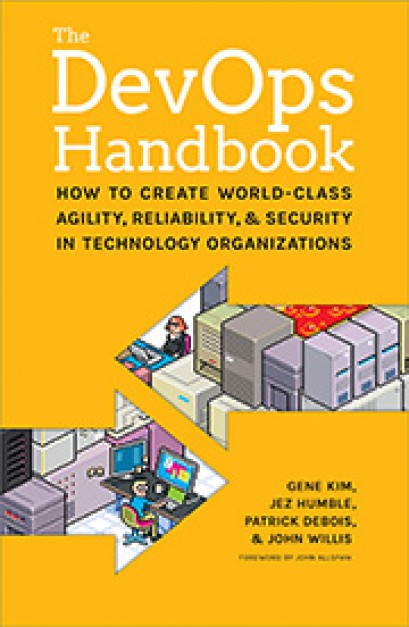11 May 2023

DevOps, a blend of development and operations, is a holistic approach to software development that focuses on collaboration, communication, and automation. Adopting a DevOps culture can significantly improve your organisation's efficiency and productivity, but the transition requires a collective effort from everyone involved.
This blog will explore the fundamental principles of building a DevOps culture and help determine whether your organisation is ready to embrace this transformative approach.
Building a thriving DevOps culture relies on shared responsibility and continuous improvement. This holistic approach emphasises the importance of the entire team working together to achieve common goals rather than having individuals focus solely on their specific tasks. As described in The DevOps Handbook, the Three Ways principles play a crucial role in shaping this culture. These principles are Flow, Feedback, and Continual Learning and Experimentation.
Flow optimises the end-to-end delivery process, ensuring that work moves smoothly and efficiently from development to operations. This requires a high degree of automation and removing obstacles that slow progress.
Feedback emphasises the importance of creating a feedback loop between operations and development teams, enabling them to identify and address issues quickly and effectively.
Continual Learning and Experimentation encourage teams to constantly look for ways to improve their processes, learn from their experiences, and innovate.
Companies often stick to familiar and comfortable practices, hindering their ability to adapt and innovate. To truly embrace a DevOps culture, organisations must:
● Be willing to experiment and challenge the status quo;
● Hold themselves accountable when problems arise; and
● Learn from mistakes and improve on the fly.
By fostering a culture of experimentation, organisations can create an environment where employees feel empowered to try new approaches and take calculated risks. This encourages innovation and helps teams discover more efficient ways of working. Additionally, holding team members accountable for their actions ensures that everyone takes ownership of their work and strives to deliver the best possible results. Finally, learning from mistakes and continuously improving processes helps organisations become more resilient and adaptable in an ever-changing business landscape.
A DevOps culture fosters a collaborative environment where development and operations teams work together throughout the entire software lifecycle. This approach emphasises open communication, shared decision-making, and continuously improving processes and practices to deliver better software faster and more reliably. In a DevOps culture, the traditional barriers between development and operations teams are broken down, enabling them to work as a cohesive unit.
To successfully build a DevOps culture, consider the following five milestones:
1.The kickoff project: Start with a small, well-defined project that demonstrates the value of the DevOps approach and helps your team learn the necessary skills. This initial project should focus on achievable goals and deliver visible results, which can help build enthusiasm and buy-in from stakeholders.
2.The start of shared decision-making: Encourage collaboration between development and operations teams by involving them in each other's processes and decision-making. This can include joint planning sessions, shared code reviews, and regular meetings to discuss progress and challenges. By fostering a sense of shared ownership, team members will be more invested in the project's success.
3.Refined collaboration and standardisation: As teams become more comfortable working together, standardise processes, tools, and practices to improve efficiency and reduce errors. Establishing clear guidelines and best practices can help create a consistent workflow across teams, making collaborating and troubleshooting issues easier. Adopting tools that facilitate collaboration and automation, such as version control systems and continuous integration platforms, can further streamline the development and deployment.
4.The ability to measure progress:
● Implement metrics to track progress and identify areas for improvement, such as deployment frequency.
● Lead time for changes.
● Mean time to recover.
● Change failure rate.
By measuring these key performance indicators (KPIs), teams can better understand their strengths and weaknesses, allowing them to make data-driven decisions and prioritise areas for improvement.
5. Operations and continual optimisation: Continuously optimise processes and practices, adjusting as needed to ensure the ongoing success of your DevOps culture. Organisations can stay agile and responsive to changing requirements and industry trends by focusing on continuous improvement. This may involve reevaluating tools, refining workflows, or exploring new technologies and techniques.
Building a DevOps culture takes time and effort. It requires patience, persistence, and a commitment to continuous learning and improvement. Your organisation will likely face challenges along the way. Still, by staying dedicated to the core principles of DevOps, you can overcome these obstacles and unlock the full potential of your team.It's essential to recognise that every organisation's journey toward a DevOps culture will be unique, with different challenges and opportunities. Some organisations may need to invest more time in training and education, while others may need to focus on breaking down organisational silos and improving communication. Regardless of the specific challenges, the key to success lies in maintaining a clear vision, setting realistic goals, and staying committed to the principles of DevOps.
As you embark on your journey towards building a DevOps culture, consider the following tips to help ensure a smooth and successful transition:
Start small and scale gradually: Begin with a pilot project that allows your team to learn and adapt to the new approach. As your organisation gains experience and confidence with DevOps, gradually expand its adoption to other projects and teams.
Invest in training and education: Provide your team members with the resources and support they need to learn new skills and adapt to new processes. This may include workshops, webinars, conferences, or online courses. Encourage a culture of continuous learning and knowledge-sharing among team members.
Promote open communication: Foster a culture of transparency where team members feel comfortable sharing their ideas, concerns, and challenges. Encourage regular meetings and open channels of communication to facilitate collaboration and ensure everyone stays informed and aligned.
Embrace automation: Automate as many processes as possible to improve efficiency, reduce human error, and free up your team's time for more strategic tasks. This can include automating testing, deployment, and monitoring processes.
Measure and iterate: Regularly assess the performance of your DevOps initiatives using relevant KPIs and make adjustments as needed. Use data-driven insights to inform your decisions and drive continuous improvement.
While the journey towards a DevOps culture may be challenging, the rewards are well worth the effort. By fostering a collaborative, transparent, and accountable environment, your organisation can experience significant improvements in productivity, quality, and overall satisfaction. Remember, the key to success lies in your team's commitment to the core principles of DevOps and their willingness to learn, adapt, and grow together.
With the right mindset, dedication, and approach, your organisation can successfully build a DevOps culture that drives innovation, enhances efficiency, and positions you for long-term success in an increasingly competitive and dynamic marketplace.
In 2010, Capital One started recognising its customers' inclination towards online and mobile options for their banking activities. The senior management decided to develop the company's technical infrastructure and set up a culture to attract and retain talented people. Capital One focused on hiring engineers and aligning them with the appropriate business-centric decision-makers in the team. Soon, the company adopted agile software development, laying the foundation for DevOps implementation. Quick response to customer feedback has always been the immediate priority at Capital One, making DevOps a natural choice to achieve faster development and deployment cycles.
Capital One approached its DevOps initiatives in three phases. They began by creating cross-functional SWAT teams to implement configuration management, automated critical processes, and improved workflows for legacy applications. This approach helped establish shared goals and teach developers and operation teams the necessary DevOps disciplines.
Capital One also leveraged a microservices architecture to increase the speed of delivery without compromising quality. The development team leveraged automated deployments compliant with their general quality standards. They created rigorous and explicit guidelines for software delivery and changes in production.
Capital One built an on-demand Amazon Web Services (AWS) infrastructure to obtain valuable user insights and respond faster. They also automated their delivery pipelines using Jenkins, which enabled them to automate their software delivery, increase operational stability, and improve the developer experience.
We can observe how Capital One applied the Three Ways principles in their DevOps journey:
● Flow: Capital One's adoption of agile practices, automated deployments and tests, and migration to the public cloud are steps that contribute to a smooth flow of work from development to operations.
● Feedback: The use of automated delivery pipelines with tools like Jenkins allows for faster feedback loops, enabling the development team to quickly address issues and make improvements. Additionally, the implementation of chaos engineering helps identify weaknesses and improve the resiliency of their applications.
● Continual Learning and Experimentation: Capital One's willingness to experiment with new technologies, such as microservices architecture and cloud infrastructure, demonstrates their commitment to continually learning and refining their DevOps practices.
It is evident that Capital One has been embracing some of their core ideas in their DevOps journey.
Capital One adopted a "clean room" approach to ensure code quality before its release. The company's virtual development "clean room" can be defined by well-defined guidelines to ensure code quality before its release. Such guidelines include identifying and registering all product pipelines, testing and scanning every code change, controlling access to production servers, etc.
Capital One followed the example of Netflix and implemented its version of chaos engineering called "Cloud Detour" to test the resilience of the applications they build. This approach helped build solutions that ensure adequate resiliency and serve as a robust disaster recovery strategy.
Capital One also embedded automated security checks into its DevOps pipeline, which helped them accelerate the assessment of misconfigurations and vulnerabilities in its containers and virtual machine images.
Adopting a DevOps culture can revolutionise your organisation's approach to software development, leading to improved efficiency, productivity, and overall success. By embracing key principles like collaboration, accountability, and continuous improvement, you can build a strong DevOps culture that empowers your team and drives innovation. Remember that this transformation takes time and dedication, but the long-term benefits of a successful DevOps culture will far outweigh the challenges faced during the transition.
● A DevOps culture is built on collaboration, communication, and automation.
● The Three Ways principles are Flow, Feedback, and Continual Learning and Experimentation.
● Successful adoption of DevOps requires a willingness to experiment, accountability, and continuous improvement.
● Building a DevOps culture involves five milestones: kickoff project, shared decision-making, refined collaboration and standardisation, measuring progress, and operations and continual optimisation.
● Developing a DevOps mentality takes time, patience, and commitment.

